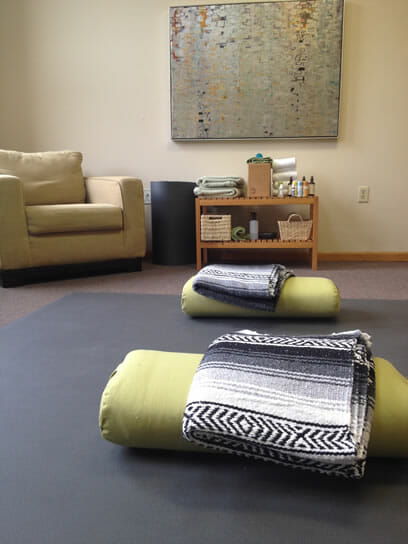Somatic Counseling
Learning How To Live In Your Body
Conscious Living Counseling & Education Center practices evidence-based wellness solutions. Our approach to mental health includes emotional, cognitive, and body awareness.
Provider, Kama Jensen, offers somatic (body-based) skills that include breath training, body awareness, and anxiety-symptom exposure.
COMMON QUESTIONS:
Why include the body in anxiety counseling?
Somatic skills are used in exposure treatment for anxiety conditions. By definition, somatic work is being aware of body sensations and responding in a helpful way.
We use the studio space to increase symptoms in the “here and now” in order to learn how to manage symptoms common with a panic attacks or general anxiety.
Why is being anxious, in session, helpful?
The stress response to real or imagined threats has a significant impact on the body. When you sense danger, it triggers an automatic physiological reaction resulting in a surge of adrenaline and the release of stress hormones. This shift creates a chain reaction in your body that results in noticeable physical and emotional symptoms.
The results include anxiety sensations, sharpened concentration, a surge of energy, and an improved ability to respond to a stressful situation. When the threat is removed, the body enters repair mode and calms. The body, in a healthy way, can go back and forth between these states. People living with anxiety conditions do not experience body sensations this way. In treatment, we practice reconnection to the body’s alarm system.
Somatic work is also an essential piece of cognitive therapy for emotion regulation as emotions are experienced in the body. The overall goal is to manage body sensations, emotions, and cognition in a helpful way.
What about relaxation therapy? Isn’t learning how to relax beneficial for an anxiety disorder?
Yes- and no. You can’t force the body to relax. You do certain things and the body relaxes. If you are practicing relaxation techniques to block out tension or to avoid feeling anxious, the technique can actually worsen an anxiety disorder.
We introduce somatic skills in a specific way. Then, the body relaxes. There is nothing wrong with experiencing anxiety or non-rhythmic breathing as the body is always in flux. Your counselor will help you learn how to practice somatic techniques in a way that is helpful for recovery.
Why do we increase anxiety in therapy?
You will learn ways to cope with current or future negative symptoms. Recovery from anxiety avoidance is an active and engaged process. It takes dedication, work, and daily effort.
It makes sense to teach a person what to do when symptoms are the worst. To do this, we may activate mood, panic, or avoidant energy states in the session.
This way, you can begin to master these states and feel more empowered to address symptoms. It’s about building confidence and success. It’s an important part of the process.
“I’m so surprised how much I learned and how often we laughed. Counseling for anxiety isn’t scary. It’s helpful, and I’m so glad I did it.”
– Female, age 31

